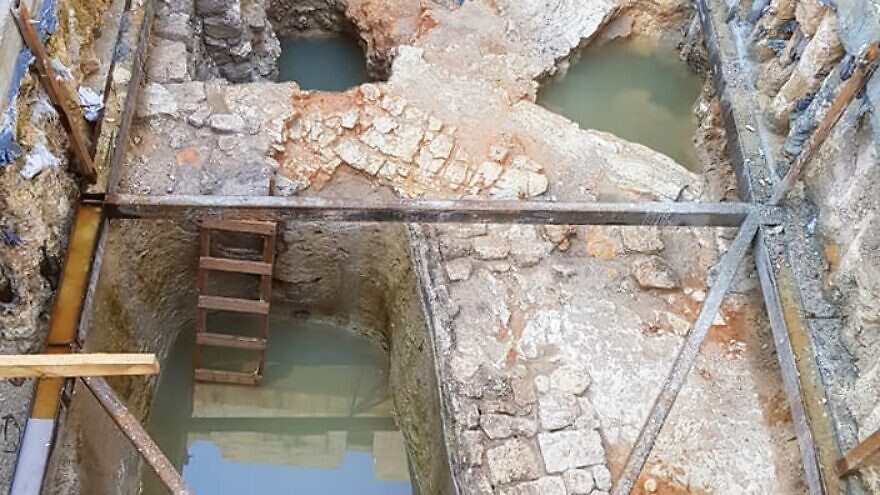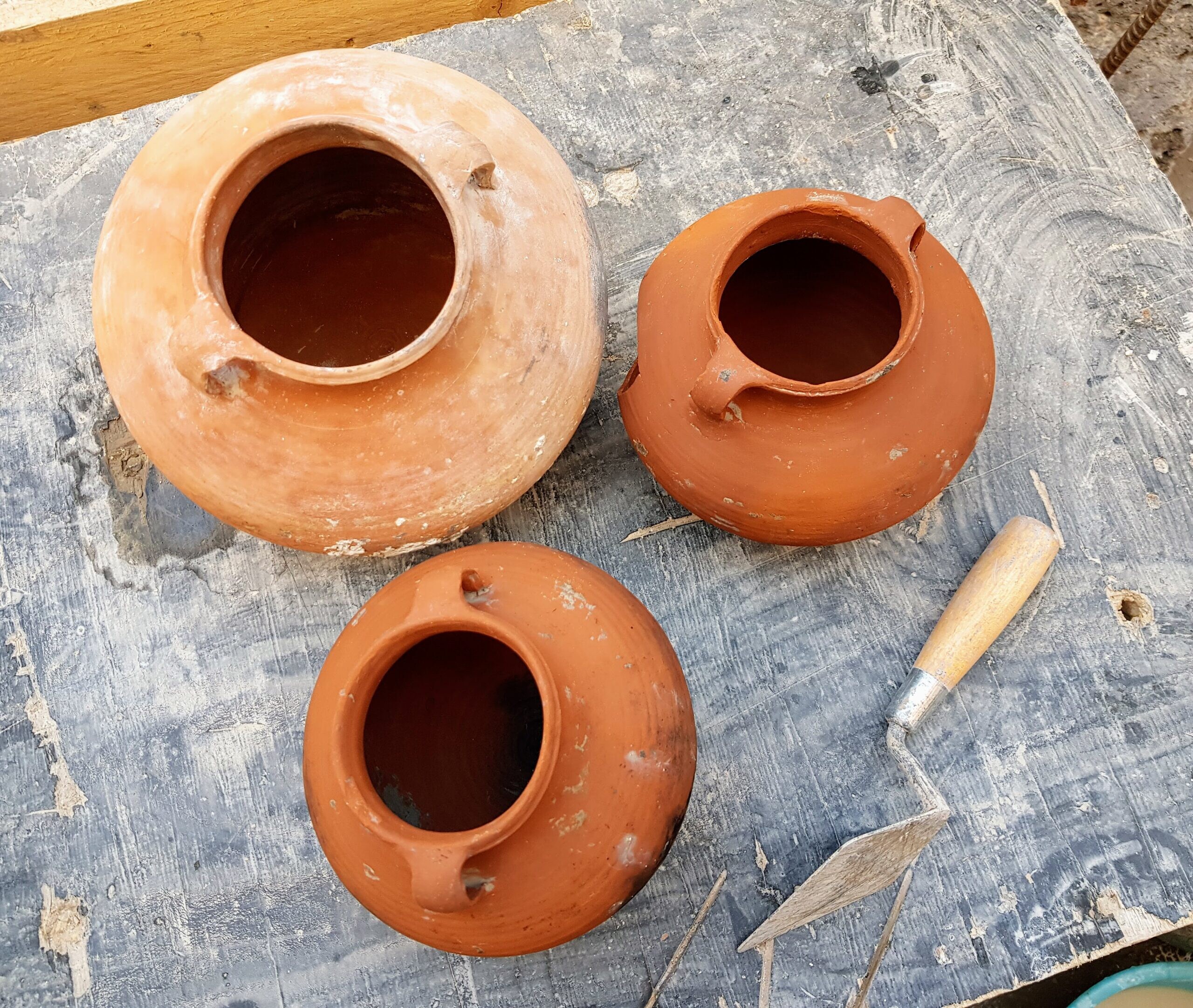Following a winter storm, melted snow and rain fill up several Herodian-period water installations. (Photo credit: Michal Haber/Hebrew University)
The Hebrew University of Jerusalem announced on Wednesday that it had unearthed an ancient Jewish ritual bath (mikveh) dating back to the Late Second Temple period, or the first century C.E.As reported by Judy Siegel-Itzkovich of Israel365 News, July 20, 2022 (photo in original):
The ritual bath was found inside a private village, the University’s statement said, “hewn into the bedrock and featuring a vaulted ceiling with fine masonry typical of the Herodian period.”
The bath is located on top of a cliff in the “Upper City”—a phrase coined by historian Josephus Flavius to describe the area of Herod’s City which housed Jerusalem’s elites, according to the statement.
“A plastered water cistern was uncovered near the same villa. It had been in use until the destruction of the Second Temple by Rome in 70 C.E., and held the remains of nearly 40 cooking pots, some still intact,” it added.
Intact Herodian-period cooking vessels collected from the bottom of the water cistern. (Photo credit: Michal Haber/Hebrew University).
The excavation, which began in February 2021, is also funded by Israel’s Jerusalem Affairs Ministry and the William Davidson Foundation.
Other finds in the area include an industrial pool built by soldiers of Rome’s Tenth Legion who were stationed in Jerusalem after the establishment of the Roman colony of “Aelia Capitolina” in 130 C.E., according to the university.
The pool lies on top of the remains of an earlier Roman oven, also installed by soldiers of the Legion. “The bottom contains a layer of tile bricks, one of which was stamped with the letters ‘LXF,’ alluding to ‘Legio X Fretensis,’ the full name of the Tenth Legion,” it stated.
The steps of the ritual bath (Photo credit: Michal Haber/Hebrew University)
...In addition to the ritual bath, the excavations unearthed additional artifacts that span the Second Temple, Roman-Byzantine and Ottoman periods, including a network of plastered pools and channels. Among the finds were a section of the Ottoman-period phase of the “Lower Aqueduct” that transported water from Solomon’s Pools near Bethlehem all the way to the Temple Mount in Jerusalem during the Second Temple period; and an industrial pool built by soldiers of Rome’s Tenth Legion who were stationed in Jerusalem after the establishment of the Roman colony of Aelia Capitolina in 130 CE. The pool lies on top of the remains of an earlier Roman oven, also installed by soldiers of the Legion. The bottom contains a layer of tile bricks, one of which was stamped with the letters “LXF,” alluding to “Legio X Fretensis,” the full name of the Tenth Legion.
Also discovered over the course of excavation was a fragment of Late Byzantine-period ceramic oil lamp, inscribed with the Greek formula “The Light of Christ shines for all.” This phrase may have its source in the ceremony of the Holy Fire, part of the Orthodox Easter celebrations in the Church of the Holy Sepulchre. Such oil lamps, dated primarily to the 6th and 7th centuries CE, may have been purchased by Christian pilgrims thronging to the Byzantine city, by then known as “Hierosolyma”.
Israelis Minister of Construction and Housing and of Jerusalem Affairs Ze’ev Elkin, inaugurated the Western Wall Elevator Project, noting “these rare finds, made during the Western Wall Elevator Project excavations, are truly exciting. They provide proof of a continuous Jewish presence in Jerusalem for millennia. Under my leadership, Israel’s Ministry of Jerusalem Affairs and Heritage will continue to preserve and develop Jerusalem’s rich Jewish past and to transform the capital into a modern, innovative city.”
Surveying the unique finds, Gutfeld commented, “The excavation revealed remains dating from the Second Temple, Roman-Byzantine, and Ottoman periods. The amount of water channels, cisterns and pools discovered in the area reflect the central role played by Jerusalem’s water supply throughout the ages.”
As noted, the highlight of the archaeological dig was the ritual bath. Haber explained the significance of this find, “during the Herodian period, the area in question was home to the city’s wealthiest residents. While several other ritual baths have been unearthed in the area, the importance of this particular discovery stems from its striking proximity to the Temple Mount—raising the question of who lived in this grand villa on the eve of the city’s destruction. It may well have been a priestly family.”
Together with Dr. Amit Reem, chief archaeologist of the Israel Antiquities Authority’s Jerusalem district, the ritual bath will be preserved and incorporated into the new Western Wall Elevator complex.
The Ministry of Jerusalem Affairs continues to develop Jerusalem’s Jewish Quarter; current projects include the Western Wall Elevator, the Tiferet Yisrael synagogue, upgrades to the Herodian Quarter and the Broad Wall archaeological site. As reported by Maayan Hoffman of All Israel News, July 21, 2022 (photos in original):
View of the ritual bath (left) and surrounding remains of Herodian-period structures (Photo credit: Assaf Peretz, Israel Antiquities Authority).
Archaeologists have unearthed a Jewish ritual bath dating back to the late Second Temple period, the Hebrew University of Jerusalem announced Wednesday.
The ritual cleansing bath, known in Hebrew as a mikveh, was discovered in a private villa reminiscent of those described by historian Josephus Flavius as belonging to the Holy City’s elite.
“During the Herodian period, the area in question was home to the city’s wealthiest residents,” explained Hebrew University’s Michael Haber, who led the excavation with Dr. Oren Gutfeld. “While several other ritual baths have been unearthed in the area, the importance of this particular discovery stems from its striking proximity to the Temple Mount—raising the question of who lived in this grand villa on the eve of the city’s destruction. It may well have been a priestly family.”
During the time of the temples, priests immersed themselves in the mikveh before carrying out their holy work. Today, some men still use these baths, especially those engaged in religious work. Orthodox religious women use them once a month, seven days after the end of their menstrual cycle.
The mikveh was discovered as part of excavations that began in February 2021 to provide handicap access between Jerusalem’s Old City and the Western Wall. The excavations were funded and spearheaded by Israel’s Ministry for Jerusalem Affairs and the William Davidson Foundation, and spearheaded by Company for the Reconstruction and Development of the Jewish Quarter of the Old City of Jerusalem.
The Western Wall, which sits below the Temple Mount in the heart of the Old City of Jerusalem, is one of Jews’ holiest sites. Tens of thousands of people pray there on Jewish holidays – especially the three Jewish pilgrimage holidays of Sukkot, Passover and Shavuot – and thousands pray there daily throughout the year.
However, to get to the site from the Jewish Quarter, one has to walk down nearly 150 steps.
In 2017, the Company for the Reconstruction and Development of the Jewish Quarter of the Old City of Jerusalem received a permit to install two elevators to make the wall more accessible to visitors. However, the project has taken longer than expected, as researchers quickly discovered layers of archaeological gems.
The most recent reports said the elevators are expected to be up and running by 2025.
The private villa in which the mikveh was discovered was hewn into the bedrock and featured a vaulted ceiling with fine masonry, which researchers said is typical of the Herodian period. The villa is located at the top of a cliff in the “Upper City,” which Josephus Flavius said housed the city’s elite population.
There were several other relics discovered in the course of the excavation, including a fragment of a late Byzantine-period ceramic oil lamp that may have been purchased by Christian pilgrims thronging to the city around the 6th or 7th century A.D.
A fragment of a Byzantine-period (“Hierosolyma”) oil lamp with remains of a Greek inscription “The light of Christ shines for all” (Photo credit: Michal Haber/Hebrew University)
The lamp is inscribed in Greek with the words, "The Light of Christ shines for all." Researchers said that this phrase may have its source in the ceremony of the Holy Fire, part of the Orthodox Easter celebrations in the Church of the Holy Sepulchre.
Artifacts from water cisterns to cooking pots dating from the Second Temple, Roman-Byzantine and Ottoman periods, were also found. A highlight was an aqueduct that is assumed to have transported water from Solomon’s Pools near Bethlehem all the way to the Temple Mount during the Second Temple period.
The Second Temple period is considered between 597 B.C. and 70 A.D., when the Temple was destroyed.
“These rare finds … provide proof of a continuous Jewish presence in Jerusalem for millennia,” said Israeli Minister of Construction and Housing and of Jerusalem Affairs Zeev Elkin.
The ritual bath will be preserved and incorporated into the new Western Wall Elevator complex, the Israel Antiquities Authority said.


.jpg)






































No comments:
Post a Comment